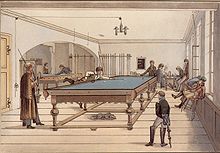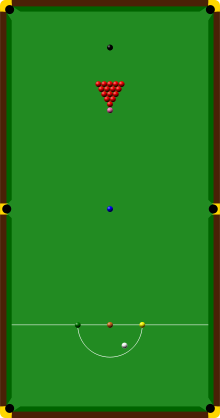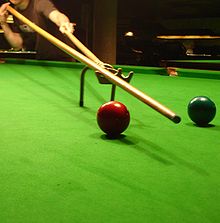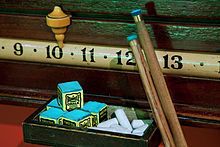Snooker (UK /ˈsnuːkər, -kə/[1] or US /ˈsnʊkər/[2]) is a cue sport that is typically played on a table covered with a green cloth or baize, with pockets situated in each of the four corners and a further two, commonly referred to as the middle, or side pockets, that sit in the middle of each of the long side cushions. The (baize) cloth on a snooker table has adirectional nap running from the baulk end of the table towards the end with the (black ball) spot. This affects how a ball rolls depending on which direction it is hit or shot. A regular (full-size) table measures 11 ft 8½ in × 5 ft 10 in (3569 mm x 1778 mm), commonly referred to as 12 × 6 ft. It is played using a cue and 22 snooker balls: one white cue ball, 15 red balls worth one point each, and six balls of different colours: yellow (2 points), green (3), brown (4), blue (5), pink (6) and black (7).[3] A player (or team) wins a frame (individual game) of snooker by scoring more points than the opponent(s), using the cue ball to pot the red and coloured balls. A player receives additional points if the opponent commits a foul. If the scores are equal when all the balls have been potted, the black is placed back on its spot as a tiebreaker. A player wins a match when a predetermined number of frames have been won.
Snooker, generally regarded as having been invented in India by British Army officers, is popular in many of the English-speaking and Commonwealth countries,[4] with top professional players attaining multi-million-pound career earnings from the game.[5] The sport is now increasingly popular in China.[6]
Contents
[show]History[edit]
Main article: History of snooker
It is commonly accepted[by whom?] that snooker originated in the later half of the 19th century.[7] Billiards had been a popular activity amongst British Army officers stationed in India, and variations on the more traditional billiard games were devised. One variation, devised in the officers' mess in Jabalpur during 1874 or 1875,[7] was to add coloured balls in addition to the reds and black which were used for pyramid pool and life pool.[8] The rules were formally finalized in 1884 by Sir Neville Chamberlain at Ootacamund.[citation needed]The word snooker also has military origins, being a slang term for first-year cadets or inexperienced personnel.[7] One version of events states that Colonel Sir Neville Chamberlainof the Devonshire regiment (not the later Prime Minister of the same name) was playing this new game when his opponent failed to pot a ball and Chamberlain called him asnooker.[8] It thus became attached to the billiards game now bearing its name as inexperienced players were labelled as snookers.[9]
Snooker grew in popularity in England but generally it was still a game for the gentry, and many well established gentleman clubs which had a billiards table would not allow nonmembers inside to play. To accommodate the popularity of the game, smaller and more open snooker-specific clubs started to be formed.
The game of snooker grew in the later half of the 19th century and the early 20th century, and by 1927 the first World Snooker Championship[7] had been organised by Joe Davis who, as a professional English billiards and snooker player, moved the game from a pastime activity into a more professional sphere.[10] Joe Davis won every world championship until 1946 when he retired. The game went into a decline through the 1950s and 1960s with little interest generated outside of those who played. In 1959, Davis introduced a variation of the game, known assnooker plus, to try to improve the game's popularity by adding two extra colours. However, it never caught on.
A major advance occurred in 1969, when David Attenborough commissioned the snooker tournament Pot Black to demonstrate the potential of colour television, with the green table and multi-coloured balls being ideal for showing off the advantages of colour broadcasting.[11][12] The TV series became a ratings success and was for a time the second most popular show on BBC Two.[13] Interest in the game increased and the 1978 World Championship was the first to be fully televised.[4][14] The game quickly became a mainstream sport[15] in the UK, Ireland and much of the Commonwealth and has enjoyed much success in the last 30 years, with most of the ranking tournaments being televised. In 1985 a total of 18.5 million viewers watched the concluding frame of the world championship final between Dennis Taylor and Steve Davis.[16] In recent years the loss of tobacco sponsorship has led to a decrease in the number of professional tournaments, although some new sponsors have been sourced;[17] and the popularity of the game in the Far East and China, with emerging talents such as Liang Wenbo and more established players such as Ding Junhui and Marco Fu, bodes well for the future of the sport in that part of the world.[6][18]
The game[edit]
Main article: Rules of snooker
The object of the game is to score more points than the opponent by potting object balls in the correct order. At the start of a frame, the balls are positioned as shown and the players take turns to hit a shot in a single strike from the tip of the cue, their aim being to pot one of the red balls and score a point. Whenever the striker pots a red ball, he or she may try to pot one of the colours. If successful, the value of the colour potted is scored, and it is returned to its correct position on the table. This process continues until the striker fails to pot the desired ball, at which point the opponent comes back to the table to play the next shot. The game continues in this manner until all the reds are potted and only the 6 colours are left on the table; at that point the colours must be potted in the order from least to most valued ball - that is, yellow first (because smallest value of 2 points), then green (3 points), brown (4 points), blue (5 points), pink (6 points) and finally black (7 points), the balls not being returned to play. When the final ball is potted, the player with more points wins.[3] A player may also concede a frame while on strike if he or she thinks there are not enough points available on the table to beat the opponent's score. In professional snooker this is a common occurrence. Points may also be scored in a game when a player's opponent fouls. A foul can occur for numerous reasons, such as hitting a colour first when the player was attempting to hit a red, potting the cue ball, or failing to escape from "a snooker" (a situation where the previous player left the cue ball where no legal ball can be struck at either edge without obstruction by an illegal ball). Points gained from a foul vary from a minimum of 4 to a maximum of 7 if the black ball is involved.[3]
One game, from the balls in their starting position until the last ball is potted, is called a frame. A match generally consists of a predetermined number of frames and the player who wins the most frames wins the match. Most professional matches require a player to win five frames, and are called "Best of Nine" as that is the maximum possible number of frames. Tournament finals are usually best of 17 or best of 19, while the World Championship uses longer matches — ranging from best of 19 in the qualifiers and the first round proper, up to 35 frames in length (first to 18), and is played over two days, extended if necessary until a winner is determined.[19]
Professional and competitive amateur matches are officiated by a referee who is the sole judge of fair play. The referee also replaces the colours on the table when necessary and calls out how many points the player has scored during a break. Professional players usually play the game in a sporting manner, declaring fouls the referee has missed, acknowledging good shots from their opponent, or holding up a hand to apologise for fortunate shots, also known as "flukes".
Other terminology used in snooker includes a player's break, which refers to the total number of consecutive points a player has amassed (excluding fouls) when at one visit to the table. A player attaining a break of 15, for example, could have reached it by potting a red then a black, then a red then a pink, before failing to pot the next red. The traditional maximum break in snooker is to pot all reds with blacks then all colours, which would yield 147 points; this is often known as a "147" or a "maximum".[20]
Accessories used for snooker include chalk for the tip of the cue, rests of various sorts (needed often, due to the length of a full-size table), a triangleto rack the reds, and a scoreboard. One drawback of snooker on a full-size table is the size of the room (22 by 16 feet (6.7 m × 4.9 m)), which is the minimum required for comfortable cueing room on all sides.[21] This limits the number of locations in which the game can easily be played. While pool tables are common to many pubs, snooker tends to be played either in private surroundings or in public snooker halls. The game can also be played on smaller tables using fewer red balls. The variants in table size are: 10 ft × 5 ft, 9 ft × 4.5 ft, 8 ft × 4 ft, 6 ft × 3 ft (the smallest for realistic play) and 4 ft × 2 ft. Smaller tables can come in a variety of styles, such as fold away or dining-table convertible.
Governance and tournaments[edit]
Organization[edit]
See also: List of snooker tournaments and Snooker organisations
The World Professional Billiards and Snooker Association (WPBSA, also known as World Snooker), founded in 1968 as the Professional Billiard Players' Association,[22] is the governing body for the professional game.[23][24][25] The amateur game is governed by the International Billiards and Snooker Federation (IBSF).[26]
Tournaments[edit]
Professional snooker players can play on the World Snooker main tour ranking circuit. Ranking points, earned by players through their performances over the previous two seasons, determine the current world ranking.[27] A player's ranking determines what level of qualification he or she requires for ranking tournaments. The elite of professional snooker is generally regarded as the "Top 16" ranking players,[28] who are not required to pre-qualify for any of the tournaments.[29] The tour contains 96 players — the top 64 from the previous two seasons, the 8 highest ranked professional players on the Players Tour Championship Order of Merit who are not in the top 64, 12 players from the Q School, and various regional, junior and amateur champions.[30]
The most important event in professional snooker is the World Championship,[31] held annually since 1927 (except during World War II and between 1958 and 1963). The tournament has been held at the Crucible Theatre in Sheffield, England since 1977, and was sponsored by Embassy from 1976 to 2005.[17] Since 2005, tobacco companies have not been allowed to sponsor sporting events in the United Kingdom, and the World Championship had to find a new sponsor. It was announced in January 2006 that the 2006–2010 world championships would be sponsored by online casino 888.com. The Championship is currently sponsored by BetFred.com after 888.com pulled out of their five year sponsorship deal after three years.[32] On 15 April 2009 the World Snooker Championship website announced that Betfred.com would be the new sponsor of the World Championship for the next four years.[33][34]
The status of winning the World Championship is great, and it is the most highly valued prize in professional snooker,[35] both in terms of financial reward (£250,000 for the winner)[36] as well as ranking points and prestige. The World Championship is televised extensively in the UK by the BBC[37] and gains significant coverage in Europe on Eurosport[38] and in the Far East.
The group of tournaments that come next in importance are the other ranking tournaments. Players in these tournaments score world ranking points. A high ranking ensures qualification for next year's tournaments, invitations to invitational tournaments and an advantageous draw in tournaments.[28] The most prestigious of these after the World Championship is the UK Championship. Third in line are the invitational tournaments, to which most of the highest ranked players are invited. The most important tournament in this category is The Masters,[39] which to most players is the second or third most sought-after prize.[40]
In an attempt to answer criticisms that televised matches can be slow or get bogged down in lengthy safety exchanges and that long matches causes problems for advertisers,[41] an alternative series of timed tournaments has been organised by Matchroom Sport Chairman Barry Hearn. The shot-timed Premier League Snooker was established, with seven players invited to compete at regular United Kingdom venues, televised on Sky Sports. Players have twenty-five seconds to take each shot, with five time-outs per player per match. While some success has been achieved with this format, it generally does not receive the same amount of press attention or status as the regular ranking tournaments.
There are also other tournaments that have less importance, earn no world ranking points and are not televised. These can change on a year-to-year basis depending on calendars and sponsors.
Criticism[edit]
Several players, such as Ronnie O'Sullivan, Mark Allen and Steve Davis, have warned that there are so many tournaments that players risk burning out. In 2012, O'Sullivan played fewer tournaments in order to spend more time with his children, and ended the 2012/2013 season ranked No. 19 in the world. Furthermore, he did not play any tournament in 2013 except the World Championship, which he won.[42]
Equipment[edit]
- Table
- The playing surface, 11 feet 8.5 inches by 5 ft 10 inches for a standard full-size table, with six pockets, one at each corner and one at the center of each of the longest side cushions. For further information see Billiard table, specifically the section Snooker and English billiards tables.
- Balls
- 22 balls (15 red, six colour balls and a white cue ball), 52.5 mm or 2 1⁄16 inches in diameter. For further information see Billiard ball, particularly the section Snooker
- Chalk
- The tip of the cue is "chalked" to ensure good contact between the cue and the cue-ball.
- Cue
- A stick, made of wood or fibreglass, the tip of which is used to strike the cue-ball.
- Extension
- A shorter baton that fits over, or screws into, the back end of the cue, effectively lengthening it. Is used for shots where the cue-ball is a long distance from the player.
- Rest
- A stick with an X-shaped head that is used to support the cue when the cue ball is out of reach at normal extension.
- Rest head adaptor
- An attachment that slips onto a conventional rest head to make a spider or just to give a slightly different bridge.
- Hook rest
- Identical to the normal rest, yet with a hooked metal end. It is used to set the rest around another ball. The hook rest is the most recent invention in snooker.
- Spider
- Similar to the rest but with an arch-shaped head; it is used to elevate and support the tip of the cue above the height of the cue-ball.
- Swan (or swan-neck spider or giraffe)
- This equipment, consisting of a rest with a single extended neck and a fork-like prong at the end, is used to give extra cueing distance over a group of balls. If not available, a regular X rest can be placed on a spider so it in turn hangs the required distance beyond to provide similar support.
- Triangle/Rack
- The piece of equipment is used for gathering the red balls into the formation required for the break to start a frame.
- Extended rest
- Similar to the regular rest, but with a mechanism at the butt end which makes it possible to extend the rest by up to three feet.
- Extended spider
- A hybrid of the swan and the spider. Its purpose is to bridge over large packs of reds. Is less common these days in professional snooker but can be used in situations where the position of one or more balls prevents the spider being placed where the striker desires.
- Half butt
- Usually housed underneath the side of the table, the half butt is a combination of a table length rest and cue which is rarely used unless the cue ball needs to be struck in such a way that the entire length of the table is the actual obstacle.
- Ball marker
- A multi-purpose instrument with a "D" shaped notch, which a referee can (1) place next to a ball, in order to mark the position of it. They can then remove the ball to clean it; (2) use to judge if a ball is preventing a colour from being placed on its spot; (3) use to judge if the cue ball can hit the extreme edge of a "ball on" when awarding a free ball (by placing it alongside the potentially intervening ball).
- Cloth
- The cloth is usually a green baize with a directional nap. The nap will affect the direction of the cue ball depending on which direction the cue ball is shot and also on whether left or right side (spin) is placed on the ball. Even if the cue ball is hit in exactly the same way, the nap will cause a different effect depending on whether the ball is hit down table (towards the black ball spot) or up table towards the baulk line. The cloth on a snooker table should never be vacuumed as this can destroy the nap, especially if the vacuum head has beater brushes. The best method is to brush the cloth in a straight line from the baulk end to the far end. Multiple brush strokes are fine as long as they are straight in direction (i.e. not across the table). Some table men will also then drag a dampened cloth wrapped around a short piece of board (like a two by four) to collect any remaining fine dust and help lay the nap down. The cloth is made of up 95% Merino Wool / 5% Nylon.[43]
Notable players[edit]
See also: List of snooker players by number of ranking titles and List of snooker players with over 100 century breaks
In the professional era that began with Joe Davis in the 1930s and continues up until the present day, a relatively small number of players have succeeded at the top level.[44] Reaching and maintaining a place amongst the snooker elite is a tough task, with the standards of the game being such that it requires many years of dedication and effort as well as natural ability.[45]
Certain players have tended to dominate the sport through the decades. John Pulman is generally regarded as the principal player through the 1960s, Ray Reardon through the 1970s, Steve Davis through the 1980s and Stephen Hendry through the 1990s. Reardon won 6 (1970, 1973–1976 and 1978), Davis also 6 (1981, 1983, 1984 and 1987–1989) and Hendry 7 (1990, 1992–1996 and 1999) World Championships. No one dominated in the 2000s, though Ronnie O'Sullivan won the title on three occasions during that decade (2001, 2004 and 2008) and Mark Williams andJohn Higgins won twice (2000, 2003 and 2007, 2009 respectively). Higgins has four world titles in total, having also won in 1998 and 2011, while O'Sullivan has five having added further titles in 2012 and 2013. By retaining his title in 2013, O'Sullivan became the first player to successfully defend the World Championship since 1996 when Hendry won the sixth of his seven titles, his fifth in a row.[46]







No comments:
Post a Comment